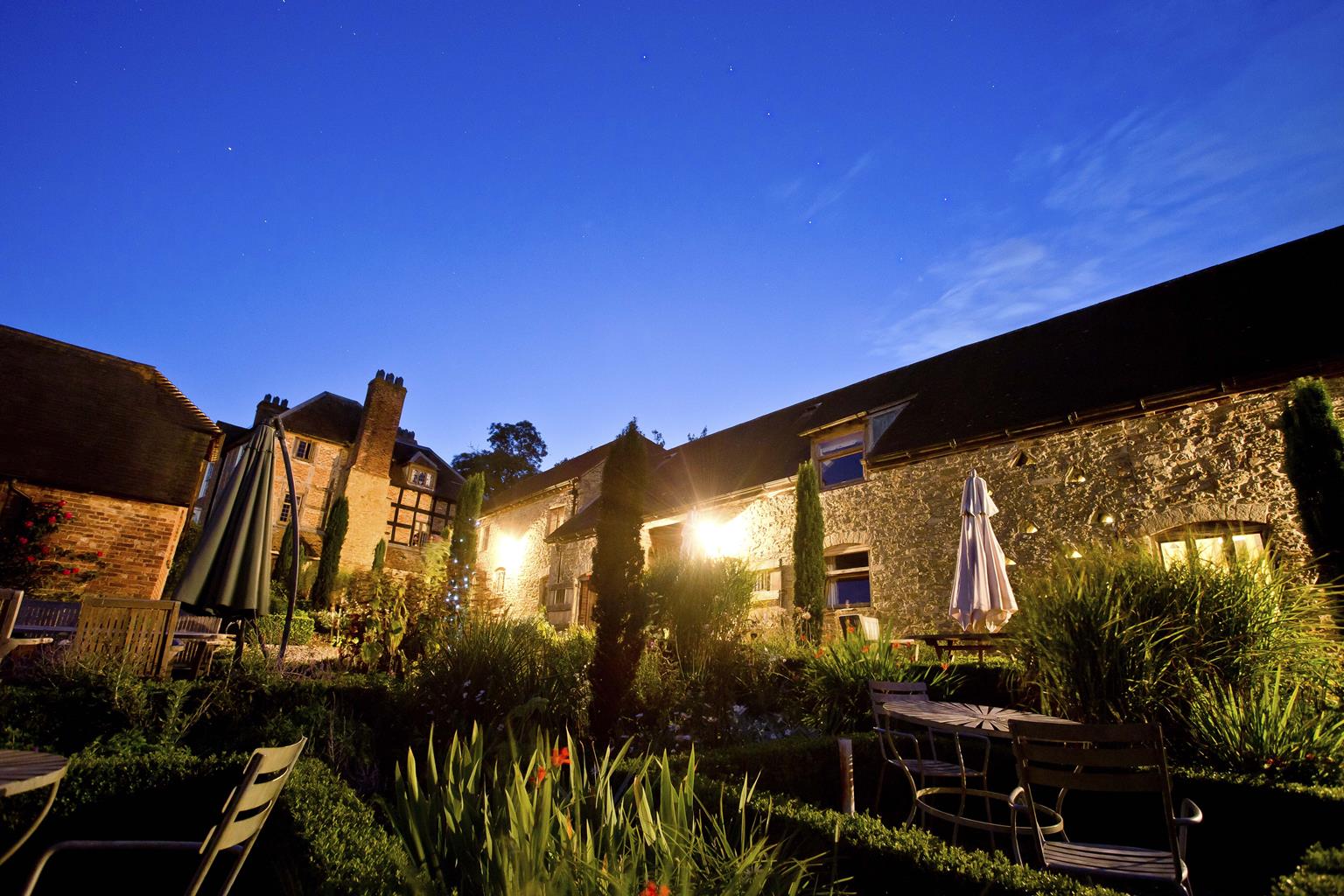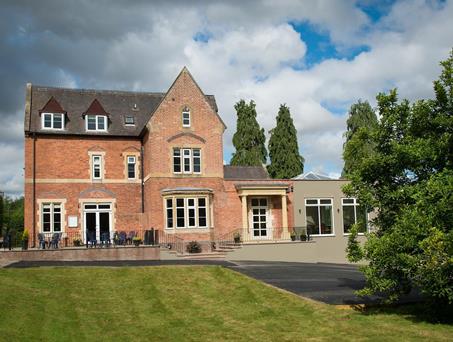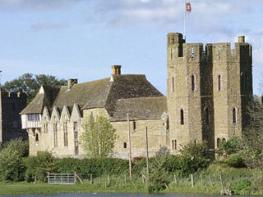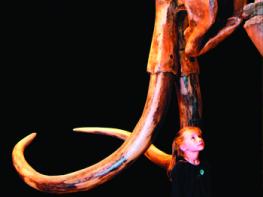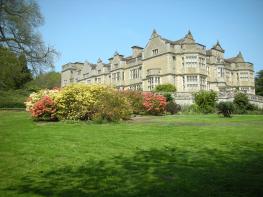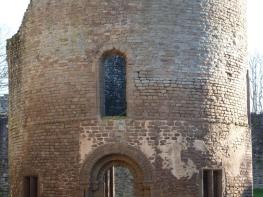Folly View is a comfortable two bedroomed, ground floor flat. It has it’s own garden with a…
Stokesay Castle and View Edge

6.25 miles (10.1kms)
About the walk
This is an exquisite walk, with the most wonderful views from the aptly named View Edge, mostly west to Clun Forest, but also east and south to the Clee Hills, Wenlock Edge, Mortimer Forest and Ludlow. Brandhill Gutter and Aldon Gutter are highlights of the walk, and considerably more salubrious than they sound - a gutter is a local name for the sort of narrow, steep-sided valley more commonly known in Shropshire as a dingle.
Medieval Fashion Statement
But, however gorgeous the landscape, it has a rival for once, in the shape of the picturesque Stokesay Castle, which isn't really a castle at all. It's a fortified manor house, which might sound like a pedantic distinction, but isn't. A true castle was defensive in purpose, and therefore strictly practical. Stokesay Castle, however, could not have resisted prolonged assault. It was part fashion statement, part status symbol, and is today the best preserved and probably the oldest example of its kind in England.
In the mid-10th century, the manor of Stoke was held by Wild Edric, a Saxon nobleman, but after the Norman Conquest it was given by William I to Picot de Say - hence the name Stokesay. ('Stoke', a common English placename, means enclosure.) Picot built a house and a church some time after 1068, but in 1280 Stokesay was sold to Laurence of Ludlow, a wool merchant, who set about rebuilding and fortifying the house. Ten generations of Laurence's descendants lived at Stokesay, but in the reign of Charles I it came into the ownership of the Craven family and was used as a supply base for the King's forces when they were based at Ludlow in the early stages of the Civil War. It was surrendered to the Roundheads, without a siege, when it came under attack. By the 19th century it had fallen into decay, and was being used as a barn. Happily, in 1869 it was sold to John Darby Allcroft, a Worcester glove manufacturer and MP, who set about restoring it. Today, Stokesay Castle is in the care of English Heritage. Stokesay's great hall is a particularly rare survival, almost untouched since medieval times and containing its original staircase, open octagonal hearth and innovative timber roof. There is also a fine solar (an upper living room), containing Elizabethan panelling and a sumptuous fireplace, accessible only by an exterior stair. Across the courtyard is a timber-framed gatehouse decorated with wonderful carvings.
Walk directions
Take the footway from the lay-by to the lane that leads to Stokesay Castle. Walk past the castle and take the second footpath on the right, at the far side of a pool. It skirts a farm, then crosses the railway. Keep straight on through three meadows on a worn path, with a succession of stiles providing further guidance.
Enter Stoke Wood, proceed to a track and turn right. Turn left at a gate marked 'Clapping Wicket' and walk past the house before turning sharp left up the field in front of it. Turn right at the top, walking by the edge of View Wood.
Join a track that leads into the wood, then emerges from it to run alongside the edge. Where it seems vague, locate a sunken track just inside the wood, which climbs to a stile, then meets a lane by Viewedge Farm
Turn left for a few paces, then join a footpath on the right. Turn right by a field-edge and walk to the top of a rise, continuing in the same direction across fields until you come to a waymarker that sends you sharp left across an adjacent field. Join a track at the far side and continue past Gorst Barn to a lane. Turn right.
Turn left on a footpath, crossing three pastures. Go right and down in the third to a concealed stile, which gives on to a bridleway. Turn left down Brandhill Gutter. Opposite Brandy Bottom Cottage, go through a gate on the right, then immediately turn left to continue in the same direction. Keep close to the stream (often dry).
After passing through a gate, the bridleway becomes narrow, uneven and eroded for a while but soon improves. It eventually crosses the stream (next to a stile) and starts to swing northwards, into Aldon Gutter. Beyond an abandoned cottage, keep right of pheasant pens to a gate. Don't go through but follow the hedge to the right.
The path becomes clear again, climbing the steep valley side to meet a lane at the top. Turn right to pass through the hamlet of Aldon, then left at a T-junction.
Join a track signed 'Byway' on the right at a slight bend in the lane. This lovely hedged track leads between fields, then descends through Stoke Wood. Ignore signs that seem to suggest you should leave the track here. Stick with it back to the railway and the lane past Stokesay Castle.
Additional information
Mostly excellent, short stretch eroded and uneven, byway from Aldon to Stoke Wood occasionally floods, many stiles
Woods and pasture in unspoiled hills above River Onny
Under control on Brandhill, Aldon and livestock
OS Explorers 203 Ludlow; 217 The Long Mynd & Wenlo
Lay-by on A49 immediately north of Stokesay turn-off
None on route
WALKING IN SAFETY
Read our tips to look after yourself and the environment when following this walk.
Find out more
Also in the area
About the area
Discover Shropshire
Perhaps nowhere else in England will you find a county so deeply rural and with so much variety as Shropshire. Choose a clear day, climb to the top of The Wrekin, and look down on that ‘land of lost content’ so wistfully evoked by A E Housman. Peer through your binoculars and trace the course of Britain’s longest river as the Severn sweeps through the county, from the Breidden Hills to Wyre Forest, slicing Shropshire in two. To the north is a patchwork of dairy fields, hedgerows, copses and crops, broken at intervals by rugged sandstone ridges such as Grinshill or Nesscliffe, and dissected by a complex network of canals.
Spilling over the border into neighbouring Cheshire and North Wales is the unique meres and mosses country, with serenely smooth lakes glinting silver, interspersed with russet-tinged expanses of alder-fringed peat bog, where only the cry of the curlew disturbs the silence. South of the Severn lies the Shropshire Hills AONB. It’s only when you walk Wenlock Edge that you fully discover what a magical place it is – glorious woods and unexpectedly steep slopes plunge to innumerable secret valleys, meadows, streams and farmhouses, all tucked away, invisible from the outside world.
Nearby stays
Restaurants and Pubs
Nearby experiences
Recommended things to do
Why choose Rated Trips?
Your trusted guide to rated places across the UK
The best coverage
Discover more than 15,000 professionally rated places to stay, eat and visit from across the UK and Ireland.
Quality assured
Choose a place to stay safe in the knowledge that it has been expertly assessed by trained assessors.
Plan your next trip
Search by location or the type of place you're visiting to find your next ideal holiday experience.
Travel inspiration
Read our articles, city guides and recommended things to do for inspiration. We're here to help you explore the UK.


